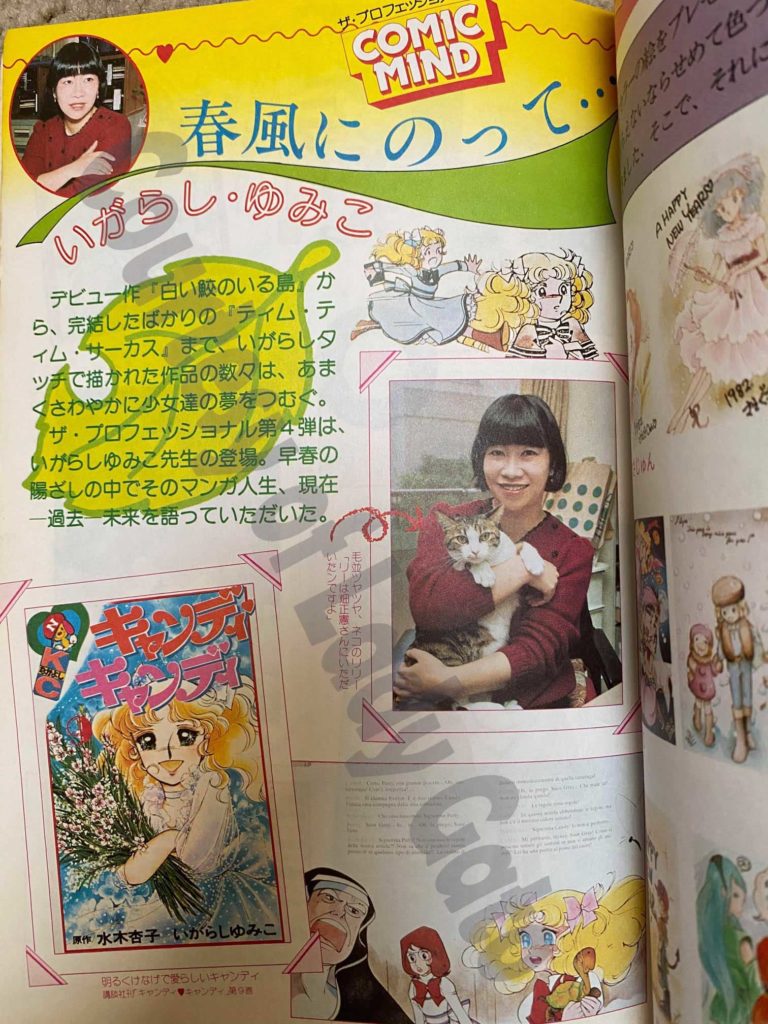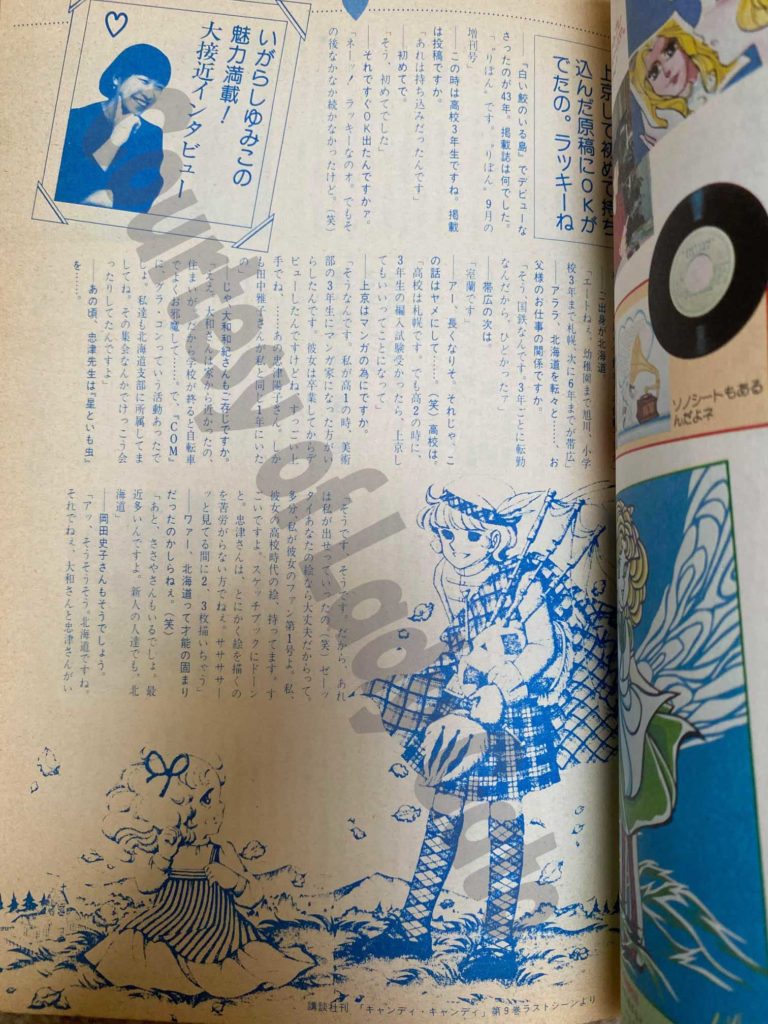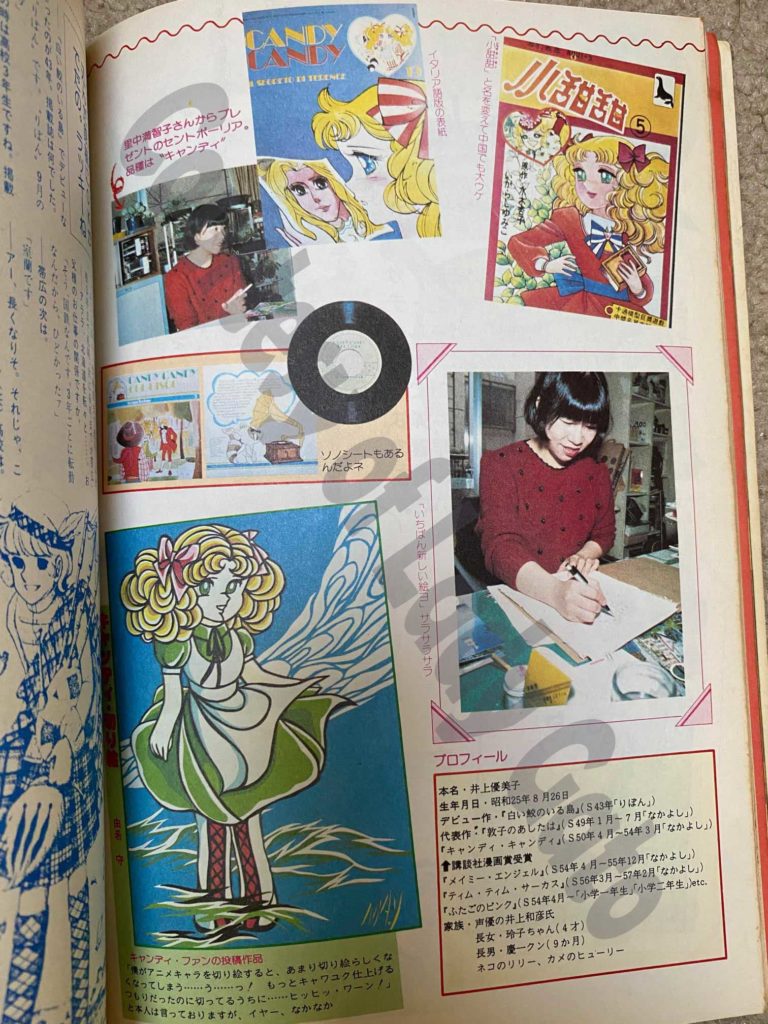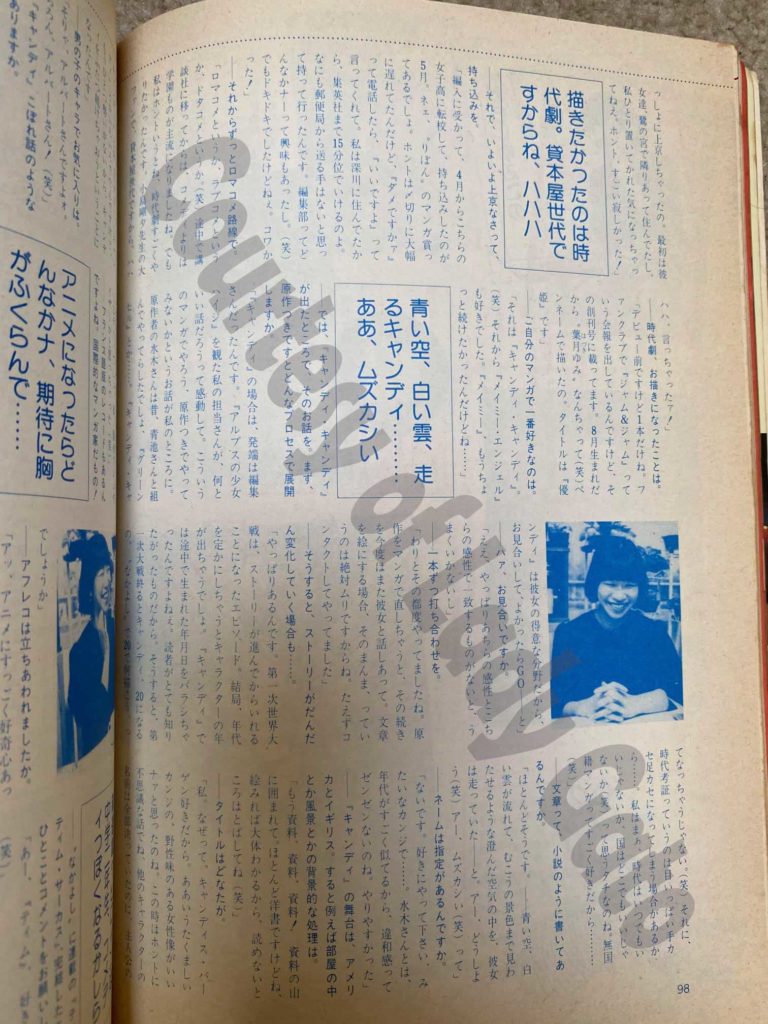© Terry’s Angels. All rights Reserved.
The Professional Comic Mind
(Translation of interview with Yumiko Igarashi in Japanese magazine Animec, published in 1982.)
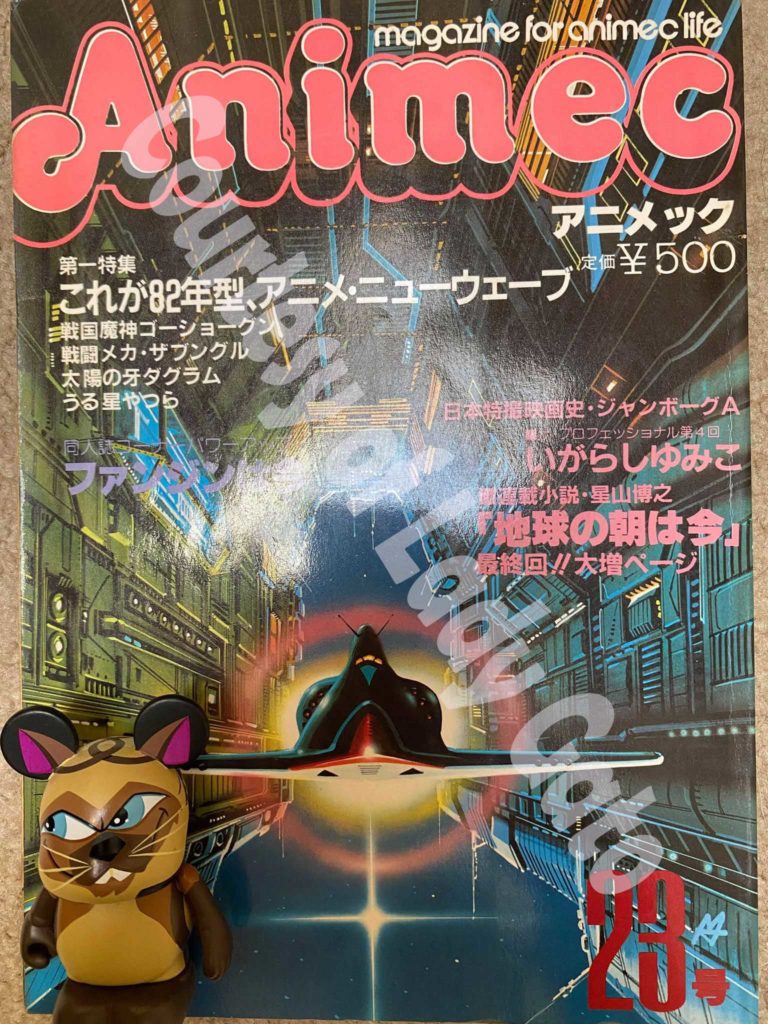
Thank you to Candy Candy Superfan Lady Gato for sharing this article.
**The content below was translated by a third-party professional translator who is a native Japanese speaker with no prior knowledge of Candy Candy. Also, be sure to read Lady Gato’s special guest essay debunking another Alfans lie about this interview being proof of a Candy-Albert ending.
On the Spring wind . . .
Yumiko Igarashi
From her debut work ‘Shiroi Same no iru Shima,’ to the recently completed ‘Tim Tim Circus,’ the numerous works drawn with the ‘Igarashi-touch’ have woven the dreams of young girls in sweet and refreshing ways.
The Professional #4 with Yumiko Igarashi. Under the sunlight of early spring, she talked to us about her life with manga, the present, past, and future.
(Images are shown in photocopies of magazine at end of this webpage.)
Photo captions:
- Lily the cat, who has shiny fur. ‘Li was given to me by Masanori Hata-san.’
- The cheerful, brave and lovable Candy. Kodanshakan ‘Candy Candy’ Vol.9.
- It’s title was changed to ‘Shao Kan Kan’ and was a success in China as well.
- My most recent drawing’ Sara-sara-sara(Onomatopoeia for smooth movement/strokes)
There is even a Sonosheet.
Art captions:
- Candy paper cut art by Mamoru Yuki.
When I make paper cut art out of anime characters, they look less like paper cut art…ugh . . .! I wanted it to come out looking more cute, but as I kept cutting . . . Ah, ah, waaan!(bark)’ Says the artist, but it’s rather impressive.
“The very first manuscript I submitted after moving to Tokyo was accepted. Lucky, huh?”
Profile
Real Name: Yumiko Inoue
Date of Birth: August 26th, 1950
Debut Work: ‘Shiroi Same no iru Shima’ (‘68 ‘Ribbon’)
Notable Works: ‘Atsuko no ashita wa’ (‘74 January – July ‘Nakayoshi’)
‘Candy Candy’(‘75 April – ‘79 March ‘Nakayoshi’)
Kodansha Manga Awards
‘Mamie Angel’ (‘79 April – ‘80 December ‘Nakayoshi’)
‘Tim Tim Circus’ (‘81 March – ‘82 February ‘Nakayoshi’)
‘Futago no Pink’ (‘79 April – ‘Shougaku Ichinensei, ‘Shougaku Ninensei) etc.
Family: Voice actor Kazuhiko Inoue
Daughter: Reiko(4 years old)
Son: Keiichi(9 months)
Lily the cat
Huri the turtle
Filled with Yumiko Igarashi’s charm! We approached her for an interview!
You debuted in ‘68 with ‘Shiroi Same no iru Shima.’ Which magazine was it?
‘It was Ribbon. The September special issue.’
You were in your third year of high school at the time. How did you submit it?
‘I actually brought it in.’
And it was your first time?
‘Yes, it was my first time.’
And they immediately accepted it.
‘Yes! I was so lucky. Of course, that didn’t continue for long (laughs).’
You were born in Hokkaido.
‘Um, I lived in Asahikawa until kindergarten, and Sapporo until the 3rd grade of elementary school, and then Obihiro until the 6th grade.’
Oh, my. You lived all over Hokkaido . . . Was it related to your father’s job?
‘Yes, it was the national railway. He was transferred every three years, which was terrible.’
And after Obihiro?
‘It was Muroran.’
Ah, this might get too long. Perhaps we should change the subject . . . (laughs). What about high school?
‘I attended high school in Sapporo. But when I was in the second grade, I passed a transfer admission test for the third grade, which would allow me to move to Tokyo.’
Were you moving to Tokyo in order to pursue manga?
‘Yes. When I was in my first year of high school, there was someone in the third grade who was in the art club who had become a manga artist. She debuted after graduating, and she was so talented. . . . It was Yoko Tadatsu-san. Not only that, but Masako Tanaka-san was with me in the first grade.’
Were you also acquainted with Waki Yamato-san?
‘Yes. Yamato-san’s house was close to mine. And so I would visit her often on my bicycle after school . . . And ‘COM’ had something called the ‘Grand Companion,’ remember? And we belonged to the Hokkaido department. And we met quite often during the gatherings.’
And during that time, Tadatsu sensei was working on ‘Hoshi to Imomushi’ . . .
‘Yes, yes. And I was the one who told her to submit it (laughs). I said that I was confident that with her art, it would be accepted. I think that I was her very first fan. I still have some of her art from when we were in high school. It’s amazing. Right there in my sketchbook! If there is one thing I can say about Tadatsu-san, it is that she never struggled when it came to drawing. Her pen would move swiftly, and before I knew it, she had two or three drawings completed.’
Wow. Maybe Hokkaido was just a mass of talent. (laughs)
‘And there’s Sasaya-san too. Yes, there seem to be a lot of them recently. Even the up and coming ones are from Hokkaido.’
That includes Fumiko Okada too, doesn’t it?‘Ah! Yes, yes, that’s right. Hokkaido. (continues on next page)
[Image: Kodanshakan ‘Candy Candy’ Vol.9 The last scene.]
‘And Yamato-san and Tadatsu-san came with me to Tokyo. At first, we lived next to each other in Saginomiya. And so I later felt as if I had been left behind. I was so lonely!’
[Animec interviewer side quote: I wanted to depict samurai dramas. After all, I’m from the rental library generation. Hahaha! ]
So, you finally moved to Tokyo and submitted your manuscript.
‘I passed the transfer admission test, and transferred to a girls’ high school here in April, and then submitted the manuscript in May. ‘Uh, you know that Manga Award you have for Ribbon? I know that I’m way past the deadline, but is it alright?’ I asked them on the phone. And they were kind enough to tell me ‘it was fine.’ Since I lived in Fukagawa, I could reach Shueisha in just 15 minutes. And so I thought that there would be no point in sending it through the post office. Besides, I was curious to see what the editorial department was like (laughs). Of course, I was still very nervous. It was scary!’
And you’ve been making romantic comedies ever since.
‘Romantic comedies, love comedies, or are they slapstick comedies? (laughs) When I moved to Kodansha later on, the trend moved away from comedies to school settings. But to be honest, what I really wanted to do was samurai dramas. I am a great fan of Goseki Kojima sensei. I’m of the rental library generation, after all. Hahaha! I said it!’
Samurai dramas. Have you ever created any?‘Just one, but it was before my debut. I was in a fan club that had a newsletter called ‘Jam & Jam,’ and it was published in one of the bonus issues. Since I was born in August, I used the pen name ‘Yumi Haduki’ (laughs). The title is ‘Yuki.’’
Which is your favorite out of your own manga? ‘Oh, that would be ‘Candy Candy’ (laughs). I also like ‘Maime Angel.’ I really wanted to continue Maime for a little longer . . .’
[Animec interviewer side quote: Blue sky, white clouds, Candy running . . . Ah, it’s so difficult.]
Well, now that ‘Candy Candy’ has been brought up, let’s talk about it. First, what is the process like when you are adapting an original work?
‘In the case of ‘Candy,’ it all started with my editor. The person who was in charge of me had seen ‘Heidi, Girl of the Alps,’ and was so moved by the wonderful story. They wanted to do something similar with manga. And so I was asked if I wanted to try adapting a novel. In fact, the author, Mizuki-san, had teamed up with Aoike-san a long time ago on something with ‘Greenhill’ in the title… And since ‘Candy Candy’ was in her field of expertise, we were supposed to meet, like in a marriage interview, and if that worked out, we would be good to go!’
Ahh. A marriage interview?
‘Yes. If there isn’t something that fits when it comes to our sensibilities, then it just won’t work out at all.
So it’s like you iron out every single detail together.
‘Yes, we had to do that often. If I change something for the manga, I would have to talk to her about it so we knew how to continue from there. Because it’s not possible to keep everything the same when turning words into pictures. So we were constantly in contact.’
And then there are times when the story starts to change . . .
‘Yes, there are. For instance, the first World War was something that was added after we had advanced in the story. In the end, if you put a date on something, it will show the ages of the characters. And so in ‘Candy,’ the dates of birth were exposed part way in. But it’s something that the readers really wanted to know. And so once World War 1 is finished, Candy is 20. And then you wonder, what story about a 20 year-old would fit ‘Nakayoshi’ magazine? (laughs). Besides, there are times when you are held back in so many ways due to staying faithful to the time period . . . But I’m the kind of person who doesn’t care which era it is in, or which country (laughs). I really like the idea of a manga that has no nationality . . . (laughs).’
Were the words written as if from a novel?
‘In most cases, yes . . . . A blue sky, with white clouds drifting. In the midst of the clear air that allowed one to see far into the distance, she ran . . . Like that. And I think, ‘Ah! What should I do? (laughs) Ah! It’s so hard (laughs).’’
Did she have any input when it came to the panel layouts?
‘No. She was like, you can do as you please . . . Mizuki-san and I are very close in age, so there was never any unease between us. It was very comfortable.’
‘Candy’ is set in America and England. And so, for instance, how did you go about dealing with backgrounds when it came to room interiors and natural scenery?
‘Oh, resources, resources, resources! I was surrounded by mountains of it. Most were western books, but I could understand the gist of them by looking at the pictures. And so I just skipped the parts that I couldn’t read (laughs).’
And who came up with the title?
‘Me. Why? Because I loved Candice Bergen. I really liked the idea of a tough woman with that kind of wild side. It’s very strange. At the time, all of the other character names had been decided. But we couldn’t settle on a name for the protagonist . . . And there were suggestions for the title, like ‘Sweet Candy,’ and ‘Lovely Candy,’ but I felt there wasn’t enough force there, so we decided to just have ‘Candy’ two times in a row.’
Who is your favorite out of the boy characters?
‘Well, it’s Albert. Of course, it is Albert! (laughs).’
Are there any tidbits about ‘Candy’ that you can share with us?
‘You know how in the last chapter, there is a two page spread drawn in the pointillist style? This scene was decided on from the moment we started. I would finish the series with this. It would all be a lie if I didn’t . But it ended up taking me three days to make all those dots. Still, it really does feel like a final chapter now, doesn’t it?’
So there is also a Chinese version of ‘Candy.’
‘Yes. ‘Shao Can Can.’ This here is the Italian version, and it’s entirely in color. There is even a Sonosheet included. But isn’t this Terry a little scary? I thought it was Grendizer at first (laughs).’
There is also a record for the French version, isn’t there? You really are an international manga artist! [Animec interviewer side quote: How would it look like as an anime? I was so full of expectation . . .]
By the way, about the ‘Candy Candy’ anime . . . You have seen it, of course?
I have it all on video.’
And how was it?
‘Hmm. It was quite hard to watch at first. I understand that there is sound and the pictures move, but the fact that it isn’t my own art that is moving was what bothered me. But I do think they got quite close to it. I made the character sheet for just the protagonist, and they based it off of that.’
I suppose you just have to be realistic about it. It’s a separate work.
‘Yes, yes. Once I saw it as something different, I thought it was quite wonderful in itself. Besides, I don’t think that readers or anime fans necessarily tied the two together. They are different . . . They enjoy anime for what it is, and manga for what it is.’
Were you present during voice recording?‘Ah! I was very curious about anime. And so I did go to a few recording sessions. I was so infatuated that I pretty much shirked my job (laughs). After all, I was a dropout at Tokyo Designer Gakuin’s animation department. I had wanted to make anime.’
Wow. The Tokyo Designer Gakuin? Those who dropout from there become important people (laughs).
‘It must have been boring for me. They just kept making me draw triangular pyramids and round columns (laughs). You study the basics during the first year. But I had already debuted as a manga artist. So when told to draw the ten degrees of light and shade with a pencil, I was like, uh, uh, uh (laughs). And so I dropped out. But perhaps we were the first generation of students? The oldest.’
So then you must have been very happy when you heard news of an anime adaptation?
‘Yes, I was very happy! What would it look like if turned into an anime? My chest was bursting with anticipation (bursts into laughter).’
[Animec interviewer side quote: A new series? The heroine is a second year in junior high school. Will it be like a comedy?]
Now that ‘Tim Tim Circus’ has ended its run in ‘Nakayoshi,’ do you have anything to say about it?
‘Ah, I really did like ‘Tim’ (laughs).’
What kind of manga will the next series be like?‘The next one starts in the April issue . . . We still only have a tentative title, but it is ‘Koronde Pokkur.’
Pokkur, like the little god?
‘Exactly. They are known as the gods under the butterbur plant. It’s set in Hokkaido, and the protagonist is a girl who is in the second grade of high school. As I want it to be as cheerful as possible, it will likely be quite comedic.’
Well, we don’t want to give away any secrets, so we’ll just say that you’ll have to read the latest ‘Nakayoshi’ to find out (laughs). At what times do you feel joy from your work?
‘It’s when I receive a fan letter saying they were moved by a certain scene, and it was the exact reaction I intended readers to have. It makes me very happy.’
And do you ever fall into a slump?
‘Hmmm. A slump . . . You could say that I do every month, or you could say that I don’t. In other words, there are times every month when I can’t draw.’
And how do you overcome that?
‘I don’t show it. My work is everything. So maybe I’ll read a novel or just spend the time aimlessly and push myself to the limit.’
Novels? Do you have any favorites?
‘I really like mystery novels. I would actually like to create a mystery manga . . . But my art doesn’t really fit (laughs).’
Who is your favorite mystery author?
‘Can’t you tell? Hmm, maybe not (laughs). Well, my favorite is William Irish.’
[Image caption: Character references that Igarashi sensei drew for the anime.]
Ah, Irish! His collection of short stories is great.‘It is, isn’t it? But his full-length novels are great too. Like ‘Phantom Lady’ and the ‘Bride Wore Black.’ Stuff like that. There is a sweetness to them.
What do you think about the present manga world when compared to the past?
‘I liked how manga of the past was very whimsical. Their themes were clear, and what was shown was something more humane and psychological. And they crafted them very well. Still, there are many people today that I am just so impressed with. Their sensibilities are just so fresh and youthful that I am overwhelmed.’
Any young manga artists in particular?
‘I seem to really take to ‘LaLa’ type artists. It’s because they have people who can create things that aren’t present in my work, and deliver them in a complete package.’
Which manga artists were you influenced by?‘I talked about Kojima sensei already, and I also love Tezuka sensei. When I was a child, my parents would buy both the boys magazine ‘Shonen’ and the girls magazine ‘Shoujo,’ and with those two, I was able to trade with my friends and read nearly all of the manga magazines that were released.’
[Side quote: Scenes that influence the reader. I want to draw as many of them as I can.]
You have two children, Igarashi sensei . . . What did you mean when you said that your style changed when they were born?
‘If I didn’t have children, then I think I would have started to raise the ages of the characters. So I suppose that my children acted as a brake. And I personally feel that it was a very good thing. But shoujo manga is very difficult. Incredibly difficult!’
Which parts in particular?
‘In other words, there are a lot of manga artists coming out now who are the same generation as their readers, right? So there isn’t much of a gap between artist and reader. In the past, readers were in elementary school or junior high school at the oldest. But now, your regular office worker reads manga. And so a twenty-something year old manga artist can draw and publish something that is their own unadulterated sensibility. In my case, the fact that I am aging is shown clearly in my work, and so there is a franticness as I try to cover for it . . .’
And so . . .
‘Yes. I might as well make something complete and give it to them . . . A work that is made by an adult and given to a child. It’s something that surely works better for me, compared to drawing a world that both the reader and I share. And my children were what made me realize this. I have a potential reader who is in such close proximity to me. I’m glad that I gave birth to a girl! (laughs). And in my next series as well, I have hopes like… ‘I want readers to look at and consider things like this, I want them to experience their youth like this, I want them to love in this way.’ Scenes that really influence the reader. I want to create and draw as many of them as I can.’
To finish up, tell us about the future.
‘I can only draw one manga a month. So I just hope that I can continue at this current pace.’
Thank you so much.
[Animec interviewer side quote: She won’t stop once she starts talking . . .’ Just as her manager had warned, the interview went over the scheduled time. With her appealingly husky voice, Igarashi sensei was cheerful, fun, and as romantic as you would expect!]
